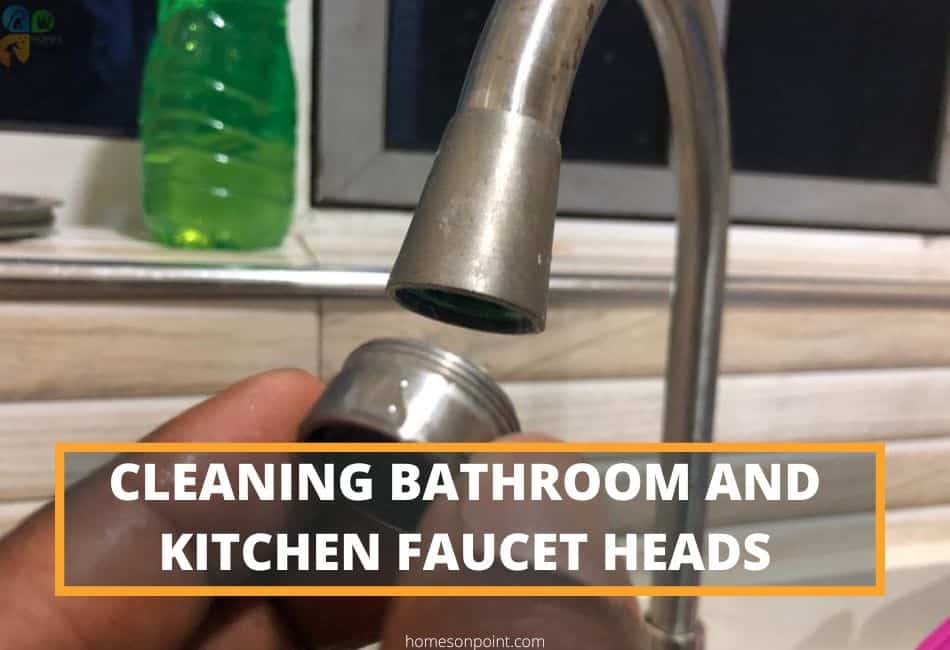When cleaning our bathroom and kitchen sinks, we focus on areas that are immediately visible such as the basin and the outside of the faucet. But there is one gunky area that we often overlook – the faucet head.
The mesh or plastic screen inside the faucet head can easily become clogged with mineral deposits and debris, which can cause the water pressure to decrease. On the outside of the faucet head, there can be hard water deposits in and around the nozzles that are gross to look at.
This is a normal occurrence, but it doesn’t mean that you have to live with a dirty faucet head. Here are three simple ways to clean the bathroom and kitchen faucet heads in your home:
- By using vinegar
- By using baking soda and vinegar
- By using a commercial cleaner
Before we get into the nitty-gritty of how to clean faucet heads with each method, let’s take a quick look at how faucet aerators and heads get so dirty in the first place.
Why Do Faucet Heads Get So Dirty?
Water contains minerals such as calcium, magnesium, and chlorine. As water flows through your home’s pipes it also picks up silt and debris. Because the aerator, mesh, or plastic screen inside the faucet head is designed to act as a filter and water saver, it traps all these minerals, silt, and debris. Over time, the faucet head will become dirty and clogged with all the dirt and grime that’s in your water.
In addition to hard water deposits, soap scum can also accumulate on the outside of the nozzles. Soap scum is caused by the combination of soap and hard water. The minerals in hard water react with the ingredients in soap to create a sticky film.
The evidence of a dirty faucet is usually seen as a decrease in water pressure and an increase in the amount of time it takes for water to flow out of the faucet. In extreme cases, you might even see pieces of dirt and grime coming out of your faucet head when you turn on the water.
How To Deep Clean Your Faucet Head
No matter which method you choose to employ to clean your faucet head, you will need to unthread the faucet head from the faucet. Some can easily be removed with the hand, while others might require the use of a plier. Do not squeeze the faucet head too tightly with the plier as you might damage it.
If your faucet has a pull-out hole that connects to the head, secure the pull-out hole with a duck tape to the spout after you unthread the head. This will prevent the pull-out hole from slipping away while you are cleaning the faucet head.
Before you start disassembling the faucet head, cover the sink drain with a plug or a rag to prevent small parts from falling down the drain. Once the head is disassembled, you can use any of the methods we are going to discuss below to clean it.
How To Clean Faucet Head With Vinegar
If you’re looking for a natural way to clean your faucet head, vinegar is a great option. Vinegar is an acidic solution that can break down mineral deposits and soap scum.
Things Needed:
- White vinegar
- A small bowl
- A toothbrush
- Toothpick/tool pick
Instructions:
Step 1
Pour some white vinegar into a small bowl. The quantity of vinegar in the bowl should be enough to submerge the faucet head.
Step 2
Put the faucet head and every little dismantled component into the bowl of vinegar. Let the faucet head soak in the vinegar for about 30 minutes to an hour. The longer you let it soak, the easier it will be to remove the deposits.
Step 3
After 30 minutes (or an hour), take out the parts from the bowl and scrub them with an old toothbrush. Use a toothpick/ tool pick to remove any stubborn deposits that are stuck in the nooks and crannies of the faucet head.
Use the tool pick to pick out any remaining pieces of rust or rocks from the mesh filter or plastic screen.
Step 4
Rinse everything under running water. Reassemble the faucet head and put it back on the faucet. Your faucet head should now be clean and free of any mineral deposits or dirt. Run the water to check for leaks. If your faucet drips, tighten the connection between the head and the faucet a bit more.
How To Clean Faucet Head With Baking Soda And Vinegar
Baking soda is another natural cleaning agent that can be used to clean a faucet head. Baking soda is a mild abrasive that can be used to scrub away dirt, grime, and mineral deposits. When mixed with vinegar, it forms a powerful cleaning solution.
Things Needed:
- Baking soda
- White vinegar
- A small bowl
- A toothbrush
- Mild soap
- sponge
- Toothpick
Instructions:
Step 1
Start by mixing equal parts of baking soda and vinegar in a small bowl. Don’t make the paste very thick else it will not penetrate the small holes and nozzles in the faucet head.
Once the two ingredients are mixed together, there will be a chemical reaction that will produce some foam. This is normal and you don’t need to worry about it.
Step 2
Dip the faucet head into the bowl of baking soda and vinegar mixture and let it sit for about 30 minutes.
Step 3
Take out the faucet head and scrub it with an old toothbrush or a rag. If you see any stubborn deposits inside the small holes, use a toothpick to remove them.
Step 4
Using a mild soap and sponge, clean the faucet head to remove any residue of the baking soda and vinegar mixture and rinse very well with clean water.
Step 5
Reassemble the faucet head and put it back on the faucet.
Using Commercial Cleaners To Clean Faucet Head
If you don’t want to use any natural solutions to clean your faucet head, you can always opt for a commercial cleaner. Sometimes, hard water and grime might have built up for a long time to the extent that the methods we have discussed above might not be enough. In such cases, you can use a commercial cleaner that is specifically designed to deal with this. One of such cleaners is CLR.
CLR is a powerful cleaner that can remove the toughest mineral deposits, dirt, and grime. Follow the following steps to get rid of deposits and grime.
Step 1
Put on latex gloves and make a mixture of water and CLR in a ratio of 50:50.
Step 2
Place the faucet head in this mixture and let it soak for about 15 minutes. This should loosen up the deposits.
Step 3
Take out the faucet head and clean the outlet with a small brush with plastic bristles. You might notice some of the ports of the head are blocked off. With the bristle ends, clear these out.
Step 4
Use the pick tool to remove any rust or small rocks from the filter or plastic screen
Step 5
Rinse the faucet head with clean water and reattach it to the faucet. Your faucet is as good as new.
Effects Of Dirty Faucet Head
A dirty faucet head can have a number of negative effects. These include;
1. Water Flowing In Different Directions
Firstly, it can cause the water to spray out in different directions instead of coming out in a steady stream. This can be very annoying and inconvenient, especially when you are trying to fill up a container or wash your hands.
2. Reduced Water Pressure
A faucet head with lots of build-ups can cause the water pressure to decrease. This is because the small holes and nozzles in the head can become blocked, thus reducing the amount of water that can flow through.
3. Bacteria Growth
A dirty, clogged or gunky faucet head can also be a breeding ground for bacteria. Bacteria thrive in moist and dark environments. If the head is not cleaned regularly, it can become a hotspot for bacteria to grow and multiply. The more the build-up, the more ideal the conditions become for bacteria inside and outside the head.
4. Health Concerns
If the water from your faucet is contaminated with bacteria, it can cause a number of health problems. When water runs out of the dirty faucet head, it carries along bacteria onto your hands, food, or body. This can create a perfect opportunity for bacteria to enter your body and cause infections.
5. Aesthetics
Lastly, a dirty faucet head can be unsightly and affect the overall look of your kitchen or bathroom. If you have a beautiful sink and fixtures, a dirty faucet head can ruin the aesthetic and make the whole area look dirty.
If you don’t take care of a filthy faucet head, it can spread and result in additional harm, such as causing your faucet to rust.
Cleaning your faucet head regularly is important to maintain not only the functionality of your faucet but also the look of your kitchen or bathroom. It is also crucial for your health and the prevention of water-borne diseases. With the above methods, you can easily clean your faucet head and get rid of all the dirt, grime, and bacteria. Happy cleaning.

